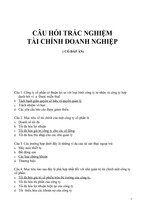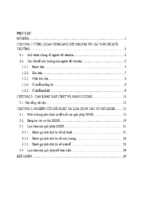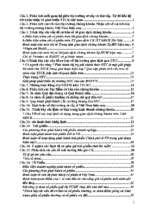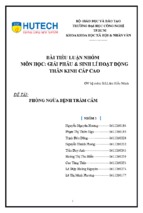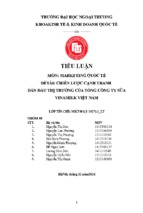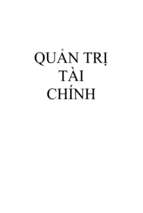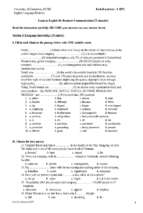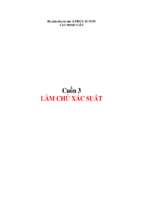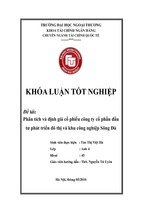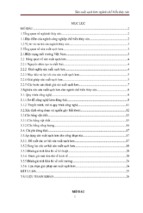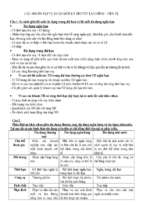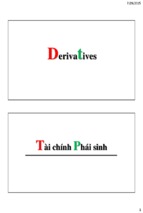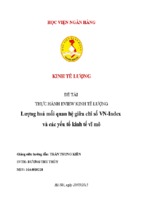Business Environment: Vietnam
Euromonitor International
01 June 2010
With a youthful population and continuing strong economic growth, Vietnam has been a preferred destination for
foreign investors. The government has taken several reform measures including a corporate income tax cut in 2009
in order to improve the country's competitiveness and business environment. Corruption, bureaucracy, a weak
judiciary system and skills shortages, however, remain prevalent problems which hinder investments to the country.
Chart 1
Source:
Note:
Ease of Doing Business 2010: Regional overview
Doing Business 2010, World Bank
Ranking covers the period from June 2008 through to May 2009. The ease of doing business index ranks economies
from 1 to 183. For each economy the index is calculated as the ranking on the simple average of its percentile
rankings on each of the 10 topics covered in Doing Business 2010, i.e. exclusive of the electricity pilot data. The
ranking on each topic is the simple average of the percentile rankings on its component indicators. A high ranking on
the ease of doing business index means the regulatory environment is conducive to the operation of business.
Rankings from 1-61 refer to easy, from 62-122 refer to moderate and from 123-183 refer to difficult.
(
Click here to
view map in detail.)
1.
ECONOMIC STABILITY
Growth strengthens but inflation accelerates
Vietnam's economy started to recover in the second half of 2009 as a result of the government's stimulus spending
and a rebound of the export sector. In 2010, annual real GDP growth rate is forecast to reach 6.0%, up from 5.2% in
2009. The current account deficit improved from 11.8% of total GDP in 2008 to 9.2% of total GDP in 2009 owing to
falling imports. The high level of current account deficit, however, will continue to make the country vulnerable to
external shocks.
Chart 2
Source:
Note:
Chart 1: FDI intensity and FDI flows 2003-2008
Euromonitor International from International Monetary Fund (IMF), International Financial Statistics and World
Economic Outlook/UN/UNCTAD/national statistics
Data for FDI outflows between 2003 and 2004 is not available.
Since early 2010, investor confidence in Vietnam has been shaken again by the country's accelerating inflation
which has been caused mainly by rising energy prices and a devaluation of the domestic currency. The annual
inflation rate is forecast to go up from 7.0% in 2009 to 12.0% in 2010, posing a challenge to the country's
macroeconomic stability. Vietnam's continuing fast economic growth, together with its large consumer market with
rising income, nevertheless, remain factors driving foreign direct investment (FDI) inflows to the country. Between
2003 and 2008, FDI inflows recorded a period growth of 249% in real terms and Vietnam has also become more
dependent on FDI.
Since the beginning of the country's economic reform in the late 1980s, the Vietnamese government has gradually
privatised state-owned enterprises in an effort to improve their efficiency as well as achieve a better balance between
the fast growing private sector and the state-controlled sector. The process, however, has been slowed down since
2009 as the economy weakened. The government aims to reduce the number of wholly state-owned companies from
1,500 as of October 2009 to 400 by 2015.
In 2009, Vietnam ranked 75th out of 133 countries in the World Economic Forum's global competitiveness index
2009-2010, down by five places compared to the 2008-2009 index. This was mainly due to a worsening of the
country's macroeconomic situation in 2008 as a result of double-digit inflation and an overheating economy. In
addition, energy shortages and infrastructure deficiencies have been factors affecting the country's competitiveness.
Corruption is widespread in Vietnam, posing another problem for investors.
Chart 3
Chart 2: Corruption perceptions index rank in selected countries 2009
Global rank out of 180 countries
Source:
Note:
2.
Transparency International
Transparency International’s Corruption Perception Index ranks 180 countries by their perceived levels of corruption,
as determined by expert assessments and opinion surveys annually.
EASE OF DOING BUSINESS
More reforms needed to improve competitiveness
Vietnam ranked 93rd out of 183 economies in the World Bank's Ease of Doing Business 2010 report. To start a
business in Vietnam it requires 11.0 procedures, takes 50.0 days, and costs 13.3% of gross national income per
capita to set up and run a local limited liability company, compared to 32.0 days in Thailand and 60.0 days in
Indonesia. Vietnam's rank in terms of starting a business went down by seven places in the World Bank's Doing
Business report 2010 compared to the 2009 report. However, this was mainly due to stronger reform efforts in other
countries.
The process of registering a property in Vietnam is considerably easier and more efficient than in its peer countries
in the region. It requires 4.0 procedures, takes 57.0 days and costs 1.1% of the property value to register or transfer a
property between companies. This is considerably lower than 4.3% of the property value required in the Philippines
and 10.7% required in Indonesia. Compared to the 2009 report, Vietnam's rank in terms of enforcing contracts
improved by seven places in the 2010 report. This was due to a reduction of the enforcing costs from 31.0% of the
claim value in the 2009 report to 28.5% of the claim value in the 2010 report.
At 172nd place out of 183 countries, Vietnam ranked low globally in terms of protecting investors due to the
inefficiency of the country's judiciary system. The process of closing a business in Vietnam takes 5.0 years for
completion, costs 15.0% of the estate with a recovery rate of 18.0 cents on the US dollar, higher than in Indonesia
(13.7 cents) but lower than in Thailand (42.4 cents).
Access to credit continues to be a constraint for small and medium-sized private enterprises (SMEs) in Vietnam. Due
to a lack of adequate credit information, personal connections and collateral assets remain the major sources of credit
in Vietnam. In an effort to improve credit information and thus SMEs' access to credit, the Vietnamese government
has enacted a new law in April 2010 which allows the operation of private credit bureaus.
Vietnam's information communication technologies (ICT) industry will become more competitive as the market will
be fully opened to foreign investors by 2012 under Vietnam's commitment to the World Trade Organisation (WTO).
Skills shortages, however, have been a factor hindering foreign investment in the ICT sector. Despite the rapid
growth, the extent of ICT penetration remains low. In 2009, the household mobile phone and broadband Internet
penetration rates stood at 27.5% and 2.0% respectively.
Table 1
Table 1: Ranking in Doing Business 2009 - 2010
Indicator
Ease of doing business
Starting a business
Dealing with Construction Permits
Registering Property
Getting Credit
Protecting Investors
Enforcing Contracts
Closing a Business
Source:
Note:
Doing business
2009
91
109
67
37
27
171
39
126
Doing business
2010
93
116
69
40
30
172
32
127
Change in rank
-2
-7
-2
-3
-3
-1
7
-1
Doing Business 2010, World Bank
(1) Rankings are based on data sets across 183 countries. Doing Business presents quantitative indicators on
business regulations and the protection of property rights that can be compared across 183 economies. (2) Ranking
for each year covers the period June-May of previous year.
3.
GOVERNMENT REGULATIONS AND TRADING ACROSS
BORDERS
Gradual ease on foreign ownership limits
Vietnam generally encourages foreign investment and considers it a part of the country's development strategy. The
investment climate has gradually improved as foreign ownership limits have been loosened to provide a more level
playing field between domestic and foreign companies. In 2009, the government raised the foreign ownership limit
in unlisted joint-stock companies from 30.0% to 49.0%. In the same year, Vietnam also fully opened its distribution
services sector to allow foreign participation in the commission, wholesale and retail services under its commitment
to the WTO. However, restrictions on foreign ownership still exist in several sectors including banking, insurance
and securities. In addition, bureaucracy, non-transparent regulations as well as a weak legal protection of investor
rights continue to be concerns for foreign investors.
In order to attract foreign investment, the Vietnamese government offers certain incentives to investors under its
Investment Law issued in 2005. For instance, foreign investors are exempt from import duties on goods imported for
their own use and which cannot be produced locally. Special tax rates and other preferential treatments are given to
investments in remote and mountainous provinces as well as in priority sectors such as information technology and
new energy sources. Foreign investors in industrial or export-processing zones are also often provided with tax and
operational incentives.
Being an export-dependent economy, Vietnam commits itself to global trade integration through participation in
bilateral, regional and multilateral trade agreements. The country became a member of the WTO in January 2007. As
of April 2010, Vietnam has concluded free trade agreements (FTAs) with ASEAN, Japan, ASEAN-China, ASEANKorea, ASEAN-Japan, ASEAN-Australia-New Zealand and ASEAN-India. Since 2008 Vietnam has negotiated an
FTA with Chile. Under its WTO commitments and FTAs, Vietnam has reduced tariffs and trade barriers.
According to the World Bank's Ease of Doing Business 2010 report, Vietnam's cost to export increased to US$756
per container from US$734 per container in the 2009 report. The cost to import also rose from US$901 per container
in the 2009 report to US$940 per container in the 2010 report. To import and export a standard shipment of goods in
Vietnam it requires submitting 6-8 documents which takes 21.0-22.0 days to complete. New customs administration
procedures as part of the WTO membership reform programme have reduced trade delays.
Chart 4
Chart 3: Trading across borders global ranking 2010
Global rank out of 183 countries
Source:
Note:
4.
Doing Business 2010, World Bank
(1) Data covers period June 2008 – May 2009. (2) Rankings are based on data sets across 183 countries.
TAXES
Corporate income taxes became more competitive
Vietnam undertook major reforms in its tax system in 2004 and 2006 in order to standardise the treatment of local
and foreign business and get the country's tax system in line with international standards. Nonetheless, tax payment
procedures still remain cumbersome. According to the World Bank's Doing Business 2010 report, it takes 1050
hours per year for an enterprise to prepare, file and pay taxes in Vietnam. This is significantly higher than
Indonesia's 266 hours.
Chart 5
Source:
Chart 4: Total tax rate and number of hours to prepare, file returns and pay taxes 2005-2009
Doing Business, World Bank
Note:
(1) Total tax rate measures the amount of taxes payable by the business in the second year of operation, expressed
as a share of commercial profits. The taxes included are profit or corporate income tax, social security contributions
and other labour taxes paid by the employer, property taxes, turnover taxes and other small taxes (such as municipal
fees and vehicle and fuel taxes). (2) Data for each year covers the period June-May of previous year.
In a government effort to stimulate the economy, corporate income tax was reduced from 28.0% to 25.0% with
effect from January 1st, 2009. In addition, two preferential tax rates of 10.0% and 20.0% will be applied for a period
of 10-15 years to newly established businesses in areas with difficult socio-economic conditions and/or in priority
sectors such as education and training, healthcare and the software producing industry. Vietnam's value added tax
(VAT) stood at 10.0% in 2009. There is no tax on labour while employers' social security and health insurance
contributions amount to 17.0% of employees' gross salaries.
Tax evasion is rampant in Vietnam given the country's large informal sector and the dominance of cash payments in
the economy. It is common among retailers not to issue VAT invoices to customers in order to evade tax payments.
Tax authorities have so far failed to control tax violations, resulting in large losses in the government's tax revenues.
Chart 6
Chart 5: Corporate income tax rate in selected countries 2009
%
Source:
Note:
5.
Doing Business 2010, World Bank
(1) Data covers period June 2008 – May 2009. (2) Tax rate refers to mandatory contributions that a medium-size
company must pay or withhold in a given year in Vietnam, as well as measures of administrative burden in paying
taxes (3) Vietnam’s corporate income tax was reduced to 25.0% as on January 2009. (4) Indonesia’s corporate
income tax was reduced to 28.0% in 2009 (5) Thailand’s rate of 30.0% is applied for income tax base exceeding
Bt3.0 million (US$87,464). For net profit below Bt1.0 million (US$29,155), a tax rate of 15.0% is applied while a tax
rate of 25.0% is applied for net profit between Bt1.0 million and Bt3.0 million. (6) Malaysia’s SMEs are subject to a
corporate tax rate of 20.0% on the first RM500,000 (US$142,857) taxable income and 25.0% on the rest as on
assessment year 2009.
LABOUR AND SKILLS
Severe skills shortages
Although Vietnam has a high adult literacy rate which stood at 91.7% in 2009, skills shortages have been a persistent
problem due to the country's inadequate and out-of-date university training as well as the existence of a “brain-drain”
problem. Shortages of technical and management skills in a wide range of sectors have posed a major challenge for
foreign investors in the country. While the Vietnamese government is keen to attract skilled Vietnamese living
overseas to come back to work in Vietnam, there has been no systematic policy on skilled immigration. Between
2004 and 2009, government expenditure on education recorded a period decline of 14.9% in real terms due to high
inflation rates as well as the fact that the government tried to contain its budget deficits.
Vietnam enjoys a young and growing workforce. Due to economic slowdown, however, the nationwide
unemployment rate rose to 2.8% in 2009 from 2.0% in 2008. The number of jobless in larger cities remains
relatively high with the unemployment rate in urban areas standing at 4.7% in 2008.
Low labour costs have been one of Vietnam's competitive advantages over its neighbouring countries in attracting
FDI. Regulations on minimum wage vary between geographical areas and economic sectors. In order to keep up
with inflation, however, minimum wages have been raised regularly in Vietnam since 2007. As of 2009, the highest
minimum wage for workers at foreign-invested companies was in Ho Chi Minh City which stood at VND1.2 million
(US$70.3) per month. This is lower than the minimum wage of US$147 per month stipulated in Shenzhen, China in
the same year. Individual annual income is taxed progressively between 5.0% (for annual income up to VND60.0
million (US$3,516)) and 35.0% (for annual income exceeding VND960 million (US$56,262)). Vietnam's
productivity stood at US$2,136 per person employed in 2009, significantly up from US$1,111 in 2004 owing to the
country's strong economic performance.
Chart 7
Source:
6.
Chart 6: Unemployment rate, economically active and employed population 2004-2009
Euromonitor International from International Labour Organisation
CONSUMER MARKETS AND DEMOGRAPHICS
Youthful population provides a demographic advantage for consumer markets
Vietnam's consumer market is still in the early stages of development but has been one of the fastest growing
markets in the region as a result of robust economic growth and rising disposable income. In 2009, per capita annual
disposable income reached VND13.4 million (US$783), representing a real growth of 5.1% over 2008. With this
income level, however, Vietnam is still classified as a low-income country and ranks behind most countries in the
region such as Indonesia (US$1,540) and the Philippines (US$1,344). The country's savings ratio stood at 5.8% of
disposable income in 2009, lower than in Thailand (10.9%) and the Philippines (7.1%).
Despite a slowdown of the economy, consumer expenditure was able to record a growth of 6.2% in real terms in
2009 over 2008. As the economy is expected to grow stronger in the coming years, the real growth of consumer
expenditure is forecast to reach 7.3% in 2010. Sectors which are expected to grow strongly in 2010 include
education, household goods and services and transport.
Vietnam is benefiting from a “demographic dividend” as the country has a large and youthful population. In 2009,
the country's total population reached 87.6 million, of which more than a quarter were aged below 14 years old. Such
demographic advantage offers an opportunity for a consumer boom if a sufficient number of jobs can be created.
Vietnam's urban population has become more affluent, providing good opportunities for consumer businesses
including those selling high-end, imported products as there is a strong preference for foreign brands among
Vietnamese consumers.
While banks have become more open to consumer loans, the consumer credit market remains relatively small in
Vietnam due to high borrowing costs as well as the people's reluctance to borrow from banks for their consumption
needs. Consumer credit, however, has been growing since 2005 as more young Vietnamese are willing to borrow
money to buy cars, houses and apartments. As the country's economic condition improves and lending conditions are
loosened, consumer credit is expected to grow more rapidly in the coming years.
Chart 8
Chart 7: Consumer expenditure by sector 2009
% of total consumer expenditure
Source:
Euromonitor International from National statistical offices/OECD/Eurostat


